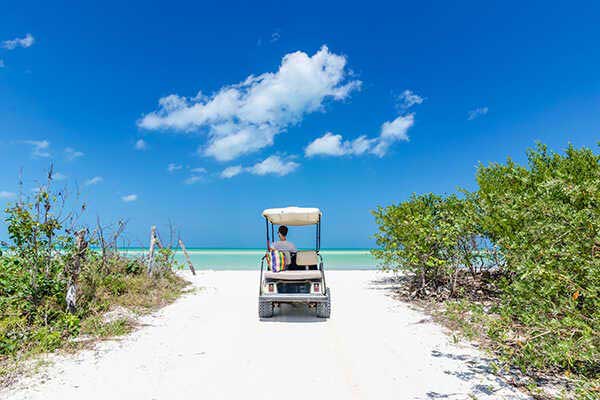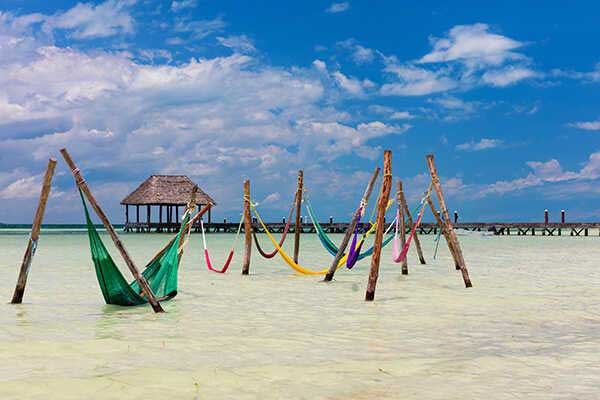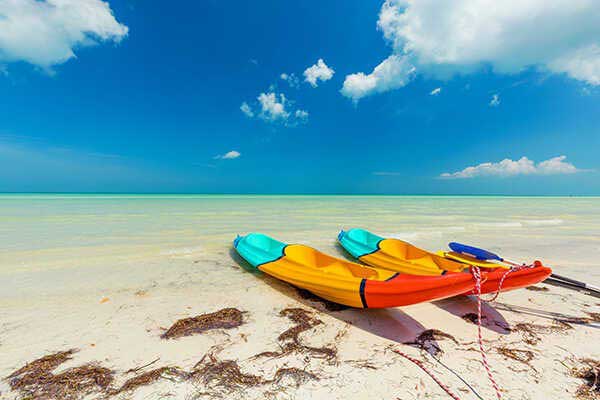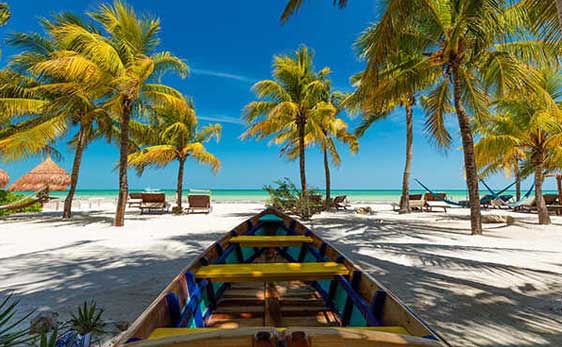Guide to Isla Holbox, Mexico - Things To Do, Safety and How To Get There
By Mark Probst
If a remote, authentic Mexican town with beautiful, quiet beaches on the Caribbean interests you but seems like a thing of the past, Holbox just might be the place for you. Pristine white sand, crystal-clear water, laid-back beach bars, and a genuine pueblo that has yet to be overrun by tourists are just a few of the reasons we enjoyed our time in Holbox, but there are other reasons why we definitely see ourselves going back soon.
Holbox, pronounced Hol-bosh, is an island in Mexico off the north coast of Quintana Roo state on the Yucatan Peninsula. The island, which is separated from the mainland by the Yalahau Lagoon, is full of diverse landscapes that are common in the state—lush mangroves over natural lagoons on one side, and gorgeous beaches surrounded by beautiful water on the other side. Holbox is actually located between the Gulf of Mexico and the Caribbean Sea—the color of the water as it hits the beach is from another world.
How to Get to Holbox

Take a bus or rent a car and make the two-and-a-half-hour drive from Cancun or Playa Del Carmen to Chiquila, in the municipality of Lazaro Cardenas. Daily car rental rates are typically low in Mexico, often advertised for $5 to $10 a day. It’s the third-party liability, which is required, that normally costs another $30 to $45 depending on the type of car and the company you’re renting from. If you add collision or higher amounts of coverage, it goes up from there. Also, if you drive you will need to park at one of the lots around the ferry terminal, so expect to pay around $5 dollars per day.
If you take the bus, the bus station is less than a five-minute walk from the ferry terminal. The bus from Cancun or Playa costs around $17 dollars each way. We opted to take the bus. We hopped on an ADO bus at the centro station in Playa Del Carmen, located right on Quinta Ave. The ADO buses are incredibly comfortable and efficient. There is also a small airport on Holbox, to which you can catch puddle jumpers from Cancun.
Arriving in Chiquila, a small town on the mainland where you catch the ferry to Holbox, it was evident that the town has been impacted by the uptick in tourism to the island. Taxi cart services, ferry and tour ticket vendors, restaurants, and other local services line the short walk from the bus station to the ferry terminal. In Chiquila, there are two companies that run ferrys to and from Holbox, 9 Hermanos and the Holbox Express, and they efficiently stagger their departure times so there is a ferry leaving every half-hour.
The ferry ride takes 30 minutes and is quite picturesque. As you approach Holbox from the south, you first notice the dense mangroves lining the island, which are part of the Yum Balam Nature Reserve. As you pull into port, you notice a sizable marina, and then a charming ferry terminal, which pours into a grand main street with yellow golf cart taxis waiting to pick you up and shuttle you off to your hotel.
We happened to be staying at a little hotel right next to the ferry terminal, so we passed on the taxi, but the first thing we noticed was oversized, almost four-wheel drive quality tires on the golf carts. It would only be a couple hours after checking in to the hotel and heading back out to understand why this was the case.
Lifestyle in Holbox

It rained our first afternoon in Holbox, a quick deluge that was over as soon as it started. In fact, we had timed it perfectly, just getting our luggage into the room before it really started, unpacking while the bulk of the rain fell, and then it was all gone by the time we were ready to head out and explore.
As soon as we headed down that main street, Calle Tiburon Ballena (Whale Shark), just a block away from our hotel, we noticed the same line of taxis, except now they were all on one side of the main street. The reason: There was a huge mud puddle on one side of the street, so large that even the carts with the oversized tires didn’t dare venture in.
Because there are no paved roads in Holbox, which we found really cool, it makes you reevaluate what shoes and/or attire you wear out. I had read and heard great things about Holbox in our previous travels to the Yucatan, including tidbits about traversing the island, and it didn’t take us long to acquiesce and make sure we were either in flip flops or barefoot for our time in Holbox.
Besides sandy roads, in Holbox you’ll notice the absence of cars. There is a real small-town feel here—taco and marquesita carts line the main square with locals lining up to eat dinner while kids play futbol on a covered, hard court that doubles as a basketball court. And all of it a block away from a world-class beach. This is why we wanted to come in the first place.

Get Your Free Mexico Report Here:
Learn more about Mexico and other countries in our daily postcard e-letter. Simply enter your email address below and we'll send you a free special report - Why Millions of Americans Are Moving to Mexico.
This special guide covers real estate, retirement and more in Mexico and is yours free when you sign up for our postcards below.
Holbox vs Tulum

One of the main reasons we felt compelled to alter our plans and check out Holbox was because of our recent trip back to Tulum for an extended stay. Once a town with a natural, cool, and spiritual vibe, chill beach bars, and an overall focus on health and wellness in nature, it now suddenly feels like it’s trying really hard to be South Beach in Miami.
We were hoping Holbox would embody some of what we used to love about Tulum, and we weren’t disappointed. Holbox has some upscale, larger resorts, but they’re not the norm yet, and they certainly don’t dominate the landscape. It’s still mostly smaller beach hotels that reminded us of another small island we love, Caye Caulker in Belize.
Traversing the island, we did see a few larger projects currently being developed on the main corridor, on the beach, and on more remote parts of the island, but the feel of the island is still that of a destination that has not been overrun with large-scale developments and tourists.
Talking to a Canadian couple who had originally come to Holbox 10 years ago, and had been back a couple times since, they commented on how the price of hotels and food had definitely gone up, especially in the last few years. While that is probably indicative of most travel destinations in Mexico, and really a global trend, we felt the cost of everyday life in Holbox was still relatively cheap. Of course, it depends on where and what you’re eating and drinking. There were definitely restaurants and beach clubs where you could pay Cancun prices, but we often ate at restaurants recommended by locals, or street food, and found the prices well under what you would expect in an expat destination.
Our hotel was a nice but basic three-star hotel with a pool, and it cost around $55 a night, during high season, which was just over the average price for most hotels in that range. There were also a few four-star hotels on the beach that were asking many times above that amount, so that option exists if that’s what you’re looking for.
It’s been a fight for many years between the residents of Holbox, who would like to control the growth and maintain the authenticity of Holbox, and developers who see the potential of what the island could be as a tourist destination. It was eye opening when we flew into Cancun the week prior and saw multiple billboards at the airport advertising Holbox as such.
The amount of attention Holbox has received over the past few years, coupled with the influx of even more tourists recently, was on the mind of many of the locals we talked with during our time there. Some residents were happy about the growth as it was improving the infrastructure, which in turn improved their daily life. Others were vehemently against Holbox becoming anything like other tourist destinations in Quintana Roo. One bartender we spoke with lamented that there were enough expat towns that have lost most of their original identity, and it was his hope that would not be the fate of Holbox.
That being said, the island is still largely considered Mexico’s best-kept secret. Overall sleepier and less developed than other Mexican beach destinations, Holbox is a great option for those looking to slow down. Both Tulum and Holbox hold their own unique beauty and appeal, and depending on the type of lifestyle you’re after—whether that be plenty of amenities and lively nightlife in Tulum or a more laid-back island retreat in Holbox—both locations attract eager visitors for a reason.
Safety in Holbox

We not only felt incredibly safe in Holbox from a crime standpoint, but we were also surprised by the lack of hustling that you become accustomed to when you are in other parts of the Yucatan. We often got street tacos and just sat in the local square, where families would be hanging out and socializing. Holbox really had the feeling of a small, safe town, and that was the sentiment that was echoed from many of the residents we spoke with.

Get Your Free Mexico Report Here:
Learn more about Mexico and other countries in our daily postcard e-letter. Simply enter your email address below and we'll send you a free special report - Why Millions of Americans Are Moving to Mexico.
This special guide covers real estate, retirement and more in Mexico and is yours free when you sign up for our postcards below.
Is Holbox Worth Visiting?

There’s no doubt that for some people, especially expats who are currently working remotely or younger travelers looking for more of a party scene, Holbox may be seen as technologically challenged, or too slow.
Holbox has a nightlife, and many of the restaurant bars and clubs are fun, with live music and dancing, but they are not the high-end bars and glitzy dance clubs now dotting every corner of the beach in Tulum.
Additionally, the Wi-Fi speed, or lack thereof, and the unreliability of basic cell phone service will drive your average digital nomad crazy. If you need to work while you are there, I highly recommend researching alternatives to relying on your hotel’s Wi-Fi service, such as buying a Telcel sim card.
With all that said, Holbox is a wonderful place to get lost, put away your computer, switch off your cell phone, and just listen to the waves on a beautiful beach while sipping a frosty beverage. And that is why we are heading back there later this year.
Things to Do in Holbox

Go to the beach, go to the beach, go to the beach! Seriously, Holbox is about being in nature in an amazing setting, and doing things on and around the water. It’s a great place for swimming, kayaking, paddle boarding, and even kite surfing, of which there are schools on the island. Riding bikes on the island is a must as well, and can be a little extreme, but the reward is jumping in the water at whatever beach you’ve ridden out to.
The beaches at Punta Cocos and Punta Mosquito are two of the most popular, but there are others worth exploring. Bottomline, the beaches are long and wide, and the water is incredibly beautiful. It’s also nice that in many areas you can wade out quite far with the water remaining shallow and picturesque.
Another great thing to do while you are in Holbox is to take some of the tours. The Three Islands Tour takes you to some of the smaller islands around Holbox, including Isla Parajos and Isla Pasion, and the Bioluminescence Tour takes you to swim in water glowing in bright bluish colors—a result of a biochemical reaction happening to certain micro-organisms in the water.
Featured Image Copyright: ©zstockphotos/iStock

